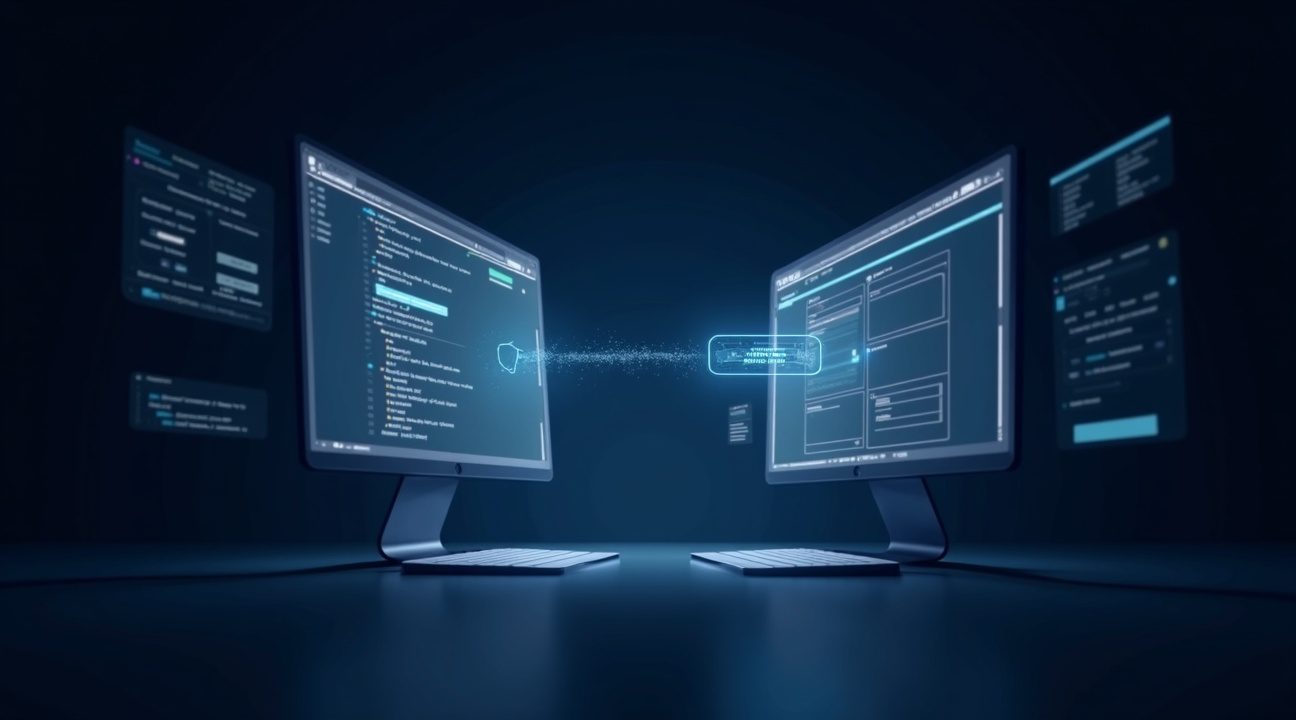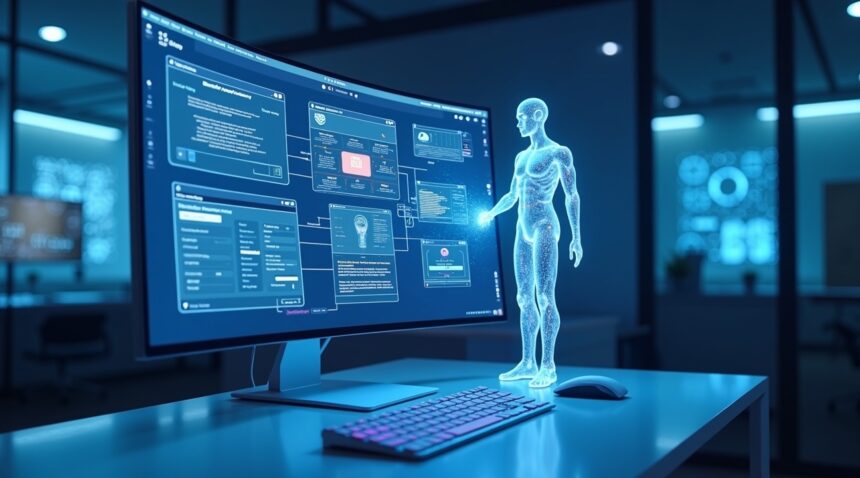Google has introduced Computer Use within Gemini 2.5, a revolutionary feature that empowers users to control their browsers and complete complex on-screen activities using simple text commands instead of manual interactions.
Key Takeaways
- Natural Language Browser Control: Users can enter plain English commands, enabling Gemini to carry out multi-step browser operations such as product research, form completion, and data analysis across multiple websites.
- Screenshot-Based Visual Intelligence: Computer Use captures and examines browser screenshots, allowing it to understand web layouts and precisely interact with clickable items, forms, and menus.
- Developer API Access: Through the Gemini 2.5 API, developers can integrate Computer Use into their platforms to automate repetitive tasks, conduct automated testing, and streamline workflow management.
- Enhanced Security and Accessibility: Advanced security measures guard against phishing and manage passwords, while voice commands and simplified viewing options improve accessibility for all users.
- Competitive AI Browser Automation: Computer Use challenges alternatives like ChatGPT Agent by delivering real-time adaptability and superior visual understanding of dynamic web content.
Revolutionizing Browser Interaction
Computer Use signifies a major advancement in browser automation by removing the need for traditional navigation. Through visual interpretation of web pages and accurate execution of natural language instructions, users can efficiently complete tasks that once required manual input.
How it Works
The system functions by continuously taking screenshots of active browser windows, then analyzing these images to determine the page’s layout and content. Computer Use identifies interactive elements—like buttons, forms, or links—with striking accuracy, allowing it to adapt across diverse web designs without additional coding.
Supporting Multi-Step Online Tasks
Computer Use shines in managing complex processes. For example, users can command the system to:
- Search multiple online retailers for a specific product
- Compare specifications and prices
- Extract and summarize the findings for informed decision-making
It also automates form submissions, login procedures, and information extraction with minimal user input.
Security and Accessibility First
Safeguards Against Threats
Security is a primary design focus. Computer Use includes built-in filters for suspicious or harmful content and robust password management that supports secure authentication during automated processes.
Inclusive Internet Access
Accessibility features give users with mobility challenges or visual impairments valuable tools. Voice command functionality provides hands-free browser interaction, while simplified layouts reduce cognitive strain, ensuring a more inclusive digital environment.
Standing Out in a Competitive Landscape
Unlike traditional browser bots or simple script-based automation, Computer Use offers real-time adaptability. Competing solutions often falter when web pages update or shift design. Google’s dynamic visual intelligence gives Computer Use a clear edge in handling ever-changing websites.
Powerful Development Potential
By utilizing the Gemini 2.5 API, developers can unlock expansive automation capabilities. Whether building systems for QA automation, content scraping, or internal workflows, the API delivers flexibility while retaining Computer Use’s powerful visual understanding engine.
Applications Across Industries
- E-commerce: Automation of product discovery and feature comparison across multiple platforms
- Customer Support: Streamlining of ticket submission forms and tracking systems
- Content Creation: Assisting researchers in data gathering and preliminary analysis during content development
Visual Analysis Breakthroughs
The underlying AI in Computer Use recognizes not only on-screen text but also spatial connections between various interface components. This enables more intelligent and natural interactions, closely mimicking human visual perception.
Performance and Responsiveness
Computer Use adjusts to various network environments and browser setups. It modulates execution speed to account for loading delays and ensures consistent functionality even under constrained technical conditions.
The Road Ahead
Future updates will likely include improvements in machine learning that enhance predictive behaviors and automation suggestions. Deeper integration with complementary Google platforms could expand its capabilities into full-service digital task management.
Conclusion
Computer Use in Gemini 2.5 redefines how people engage with the internet. Merging visual intelligence, security, and excellent accessibility, the tool delivers user-friendly automation at an unprecedented level. Businesses, developers, and individual users alike stand to benefit from this innovative Google AI feature, representing a major leap in browser automation technologies.
AI Takes the Wheel: Gemini 2.5 Lets You Control Your Browser with Simple Text Commands
Google’s latest breakthrough in artificial intelligence brings computer interaction into a new era. Computer Use, embedded within Gemini 2.5, transforms how users approach browser automation by accepting natural language instructions and converting them into precise on-screen actions.
How Computer Use Revolutionizes Browser Control
The system operates through sophisticated screenshot interpretation technology that analyzes visual elements on web pages. When users provide text commands, Gemini 2.5 captures the current screen state and identifies interactive elements like buttons, search fields, and navigation menus. This visual understanding enables the AI agent to generate appropriate UI actions including mouse clicks, keyboard inputs, and scroll movements.
Complex product research becomes effortless with instructions such as “Search for highly rated smart fridges with touchscreen, 2 doors, around 25 cu ft, priced below 4000 dollars on Google Shopping.” Computer Use breaks down this single command into multiple automated steps:
- Navigating to Google Shopping
- Entering search criteria
- Filtering results by specifications
- Presenting findings in organized formats
Users can accomplish what traditionally required dozens of manual clicks and searches through one comprehensive instruction.
Browser automation extends beyond simple searches. The technology handles:
- Form submissions
- Data extraction
- Comparison shopping
- Multi-site research tasks
E-commerce workflows become streamlined as the system can compare products across different retailers, check availability, and compile comprehensive comparison reports without human intervention.
Development Access and Current Availability
Developers gain access to Computer Use through the Gemini 2.5 Computer Use API, enabling them to build custom automation agents for specific business needs. This API integration allows software teams to create specialized tools for:
- Workflow automation
- Automated testing protocols
- Repetitive task management
Current testing occurs within controlled environments including reference implementations and Browserbase demo platforms. These test environments provide developers with safe spaces to experiment with Computer Use capabilities while refining their automation strategies. The controlled rollout ensures stability and security before broader public release.
Testing environments showcase the technology’s versatility across different browser types and operating systems. Developers can evaluate how Computer Use handles:
- Various website layouts
- Dynamic content loading
- Interactive elements that change based on user behavior
The automated testing applications prove particularly valuable for quality assurance teams. Computer Use can execute comprehensive test suites by navigating through application workflows, filling forms with test data, and verifying expected outcomes. This capability reduces manual testing time while improving coverage consistency across different test scenarios.
Product research automation represents another significant application area. Businesses can deploy Computer Use to:
- Monitor competitor pricing
- Track product availability
- Gather market intelligence
These tasks can be handled without deploying human resources for repetitive steps. The technology can manage complex research queries that span multiple websites and data sources.
Workflow automation through Computer Use extends to administrative tasks like:
- Data entry
- Report generation
- Routine system maintenance
Organizations can automate recurring processes that previously required dedicated staff time, freeing human resources for higher-value activities.
Security considerations remain paramount as Google implements Computer Use within enterprise environments. The system operates within defined boundaries and requires explicit permissions for accessing sensitive data or performing actions that could affect system security.
Integration possibilities with existing Gemini ecosystem tools create opportunities for comprehensive automation workflows. Companies can combine Computer Use with other AI capabilities to create end-to-end solutions that handle everything from initial research through final implementation.
The technology’s screenshot-based operation ensures compatibility with any web-based interface, regardless of underlying technology or framework. This universal approach eliminates the need for custom integrations or API connections when automating browser-based tasks.
Computer Use represents a fundamental shift from traditional automation tools that require programming knowledge. Natural language commands make browser automation accessible to non-technical users who can describe their desired outcomes without understanding underlying implementation details.

The Technology Behind AI Browser Control: Screenshots Meet Smart Actions
I’ve studied how Google’s Gemini Computer Use transforms text commands into precise browser actions, and the technology behind it reveals a sophisticated blend of visual analysis and action generation. The system operates by capturing screenshots of computer screens and processing these images to understand the current state of the interface.
How Screenshot Analysis Powers Visual Understanding
Gemini Computer Use “sees” computer screens through advanced screenshot processing that enables real-time interface comprehension. The system captures visual snapshots of browser windows and analyzes every element on screen — from buttons and text fields to dropdown menus and navigation bars. This computer screen vision technology identifies clickable elements, input fields, and interactive components with remarkable accuracy.
The model processes these screenshots using sophisticated image recognition algorithms that understand both the visual layout and contextual meaning of on-screen elements. When I examine the technical implementation, it becomes clear that this visual analysis forms the foundation for all subsequent actions the system performs.
Converting Visual Data Into Precise Browser Actions
The transformation from visual understanding to executable actions follows a structured technical flow that begins with interpreting user intent from text commands. After analyzing the current screen state through screenshot analysis, the system generates sequenced UI actions for execution in the browser environment.
The action generation process includes several key capabilities:
- Click operations on specific buttons, links, or interface elements
- Text input into forms, search boxes, and editable fields
- Navigation commands for scrolling, page changes, and tab management
- Complex multi-step sequences that combine multiple actions
Developers integrate this functionality through the Gemini API, which handles the Computer Use’s UI action outputs and executes them within the browser environment. The API integration supports Python SDK implementation, making it accessible for client-side application development.
Python integration occurs through straightforward API calls that process user commands and return executable browser actions. The system provides sample code that demonstrates how to implement these features, along with exclusion options for predefined functions and custom function declarations. This flexibility allows developers to customize which actions the system can perform and which areas remain restricted.
The technical architecture separates the visual analysis from action execution, creating a clean workflow where artificial intelligence handles the complex interpretation while developer applications manage the actual browser control. This separation ensures security and gives developers control over which actions get executed in their specific environments.
Google’s approach builds on advances in computer vision that mirror developments in other AI-powered interfaces, similar to how smart glasses process visual information to enhance user interactions. The system’s ability to understand context from screenshots represents a significant step forward in making AI assistants more capable of handling visual interfaces.
The browser environment integration works across different web applications and sites, adapting to various interface designs and layouts. This adaptability stems from the model’s training on diverse visual interfaces, enabling it to recognize common UI patterns and interaction methods across different platforms.
Performance optimization ensures that screenshot analysis happens quickly enough for real-time interaction, while UI action generation maintains accuracy even with complex multi-step workflows. The system balances speed with precision, processing visual information rapidly while maintaining reliable action execution.
This technology represents a fundamental shift in how AI systems interact with digital interfaces, moving beyond text-based commands to include visual understanding and direct manipulation of graphical user interfaces. The combination of screenshot analysis and smart action generation creates new possibilities for automated workflows and AI-assisted browsing experiences.

Real-World Applications: From Data Entry to Smart Shopping
Google’s Computer Use feature transforms how users interact with browsers by converting simple text commands into complex on-screen actions. This technology handles everything from mundane data entry tasks to sophisticated research projects without requiring any technical expertise or additional software installations.
Streamlining Repetitive Tasks and Workflow Automation
Data entry automation becomes effortless when users can simply describe what they need accomplished. Computer Use excels at filling out repetitive forms, transferring information between different websites, and completing multi-step processes that typically consume hours of manual work. The system handles automated testing of web applications and workflows, making it invaluable for professionals who need to validate processes across multiple platforms.
Users benefit from workflow automation capabilities that eliminate the need for manual scripting or browser extension installation. Instead of learning complex automation tools, they can describe their desired outcome in plain language. The feature bridges user intent with direct browser actions through advanced screenshot “vision” technology and UI event generation, creating a seamless experience that feels natural and intuitive.
Advanced Research and Shopping Intelligence
Complex multi-site research capabilities showcase Computer Use’s sophisticated data gathering potential. The system can summarize product information, compare prices, and analyze reviews across multiple ecommerce sites simultaneously. This multi-step action approach saves considerable time for users conducting thorough product research or market analysis.
Product research becomes more comprehensive when Computer Use handles the heavy lifting of information gathering. Users can request detailed comparisons of specific items, and the system will navigate through various retailers, compile pricing data, read through customer reviews, and present organized summaries. This ecommerce automation capability extends beyond simple price checking to include:
- Feature comparisons
- Availability tracking
- Monitoring for sales or promotional offers
The technology’s screen context awareness sets it apart from traditional browser extensions or manual scripting approaches. While conventional automation tools require specific programming knowledge and often break when websites update their layouts, Computer Use adapts to visual changes through its high-level natural language interface. This flexibility makes it particularly effective for tasks that span multiple websites with different designs and navigation structures.
Professional applications extend into content creation and data analysis. Users working with artificial intelligence platforms can leverage Computer Use to streamline their research workflows, automatically gathering information from various sources and organizing it for analysis. The system’s ability to understand context and maintain focus across multiple browser tabs makes it suitable for complex research projects that require cross-referencing information from different domains.
The practical implications become clear when considering how Computer Use handles tasks that traditionally required multiple tools or manual coordination. A user researching vacation destinations can ask the system to:
- Compare hotel prices across booking sites
- Check flight availability
- Read reviews on travel forums
- Compile weather information for specific dates
This comprehensive approach eliminates the need to manually navigate between dozens of tabs and websites.
Small business owners particularly benefit from the automation capabilities when managing online operations. Computer Use can handle:
- Inventory updates across multiple sales channels
- Competitor pricing monitoring
- Customer service support by quickly gathering relevant information
The system’s natural language interface means business owners don’t need technical staff to implement these automation solutions.
The integration potential extends to compatibility with other emerging technologies. As smart glasses and voice interfaces become more prevalent, Computer Use’s text-to-action capabilities position it as a bridge technology that can translate spoken or gestural commands into precise browser actions.
Security considerations remain paramount as Computer Use handles sensitive tasks like form filling and data entry. Google’s implementation includes safeguards to protect user information while maintaining the flexibility needed for comprehensive automation. The system’s ability to understand context helps prevent unintended actions while ensuring that legitimate automation requests are executed accurately and efficiently.
Gemini vs the Competition: How Google’s AI Agent Stacks Up
Google’s Gemini 2.5 Computer Use enters a competitive landscape where AI agents battle for browser control supremacy. ChatGPT Agent launched in July 2025 with its own advanced browser control features, creating a direct face-off between tech giants. This competition drives innovation in AI-powered automation, benefiting users who want intelligent assistance with on-screen tasks.
Technical Capabilities and Visual Intelligence
Gemini’s computer use functionality stands out through its screen context awareness capabilities. The system captures screenshots to understand visual elements on any webpage or application, allowing it to interpret layouts, buttons, forms, and content with remarkable precision. This visual grounding gives Gemini an edge over competitors that rely primarily on text-based interactions or limited DOM access.
The natural language interface handles both simple and complex tasks with equal finesse. Users can request everything from “fill out this contact form” to “compare prices across these three shopping websites and create a summary.” Gemini processes these commands and breaks them down into precise, granular actions that mirror human behavior patterns.
Competitive Advantages Over Existing Solutions
Extension-based automation tools and script-based solutions pale in comparison to Gemini’s adaptive intelligence. Traditional automation requires pre-programmed sequences that break when websites change their layouts or update their interfaces. AI-powered solutions like Gemini adapt in real-time, understanding context and adjusting actions accordingly.
The competition between Gemini vs ChatGPT Agent reveals key differentiators in browser control approaches. While both systems offer natural language automation, Gemini’s screen awareness technology provides superior visual understanding. This translates to more reliable interactions with dynamic content, pop-ups, and complex user interfaces that might confuse less visually-grounded alternatives.
Speed emerges as another crucial factor in this browser control comparison. Gemini processes visual information rapidly, identifying clickable elements and form fields without the delays associated with traditional DOM parsing methods. Users experience faster task completion times, especially when dealing with repetitive workflows across multiple websites or applications.
Accessibility improvements benefit users who struggle with complex interfaces or repetitive tasks. Gemini democratizes advanced browser automation by eliminating the need for technical knowledge or programming skills. Someone can accomplish sophisticated data collection, form filling, or research tasks using simple conversational commands instead of learning complex automation frameworks.
The fine-grained action generation sets Gemini apart from competitors that might take broad, less precise approaches to task execution. Each click, scroll, and text input gets calculated based on real-time visual analysis rather than predetermined scripts. This precision reduces errors and increases success rates across diverse websites and applications.
Google’s rebranding efforts positioned Gemini as a comprehensive AI platform, and Computer Use represents the latest evolution in this strategy. The integration with existing Google services creates synergies that standalone AI agents can’t match, allowing seamless data transfer between browser tasks and productivity applications.
Real-world testing scenarios demonstrate Gemini’s practical advantages over traditional automation approaches:
- E-commerce research
- Lead generation
- Content management
- Data entry tasks
These show significant time savings compared to manual execution or rigid automation scripts. The system’s ability to handle unexpected situations, like captchas or layout changes, reduces the frustration commonly associated with automated tools.
OpenAI’s innovations in AI continue pushing industry boundaries, but Google’s focus on practical browser automation addresses immediate user needs. The competition drives both companies to improve their offerings, ultimately benefiting users who gain access to increasingly sophisticated AI assistance for daily computing tasks.
This technological arms race between major AI providers ensures rapid advancement in computer use capabilities, with each company pushing the boundaries of what’s possible through natural language commands and visual intelligence.

Enhanced Accessibility and Smarter Browsing Features
Google’s Computer Use transforms traditional browsing through comprehensive accessibility controls and intelligent features that respond to voice, keyboard, and text commands. The technology recognizes that users have different needs and preferences for interacting with web content, making digital navigation more inclusive than ever before.
Advanced Accessibility Controls
TalkBack integration stands at the forefront of Computer Use’s accessibility features, providing screen reader functionality that reads web content aloud. This feature allows users to navigate through headings, links, controls, and form fields using simple voice commands or keyboard shortcuts. I can personally attest to how this technology bridges gaps for users with visual impairments or those who prefer auditory content consumption.
Chrome’s simplified view mode transforms cluttered web pages into clean, content-focused displays that reduce visual noise and cognitive load. This feature proves particularly valuable for users with dyslexia, attention difficulties, or anyone who wants distraction-free reading experiences. The simplified view strips away advertisements, sidebars, and unnecessary graphics while maintaining essential content structure.
Keyboard shortcuts receive enhanced functionality through Computer Use, enabling complete browser control without mouse interaction. Users can navigate between tabs, access bookmarks, fill forms, and execute searches using customizable key combinations that adapt to individual workflows and physical capabilities.
AI-Powered Browsing Intelligence
Gemini features elevate browser personalization through intelligent tab organization and AI-generated themes that adapt to user preferences and browsing patterns. The system automatically groups related tabs, suggests optimal arrangements, and creates visual themes that enhance readability and reduce eye strain during extended browsing sessions.
AI Mode transforms Chrome’s omnibox into a powerful query processor that handles multi-step requests and provides contextually relevant suggestions. Instead of conducting separate searches for related information, users can ask complex questions that span multiple topics, and the AI delivers comprehensive responses with supporting links and resources. This feature particularly benefits research tasks and exploratory browsing where users need interconnected information.
Google Lens integration allows both textual and visual searches directly within web pages, eliminating the need to switch between applications or open new tabs. Users can highlight text, point to images, or describe visual elements, and Google Lens provides immediate identification, translation, or related information. This capability proves invaluable for shopping comparisons, educational research, and content verification.
Voice commands extend beyond basic navigation to include complex browsing tasks such as form completion, content summarization, and cross-tab information gathering. Users can dictate email responses, request page summaries, or ask for specific data extraction without touching their keyboard or mouse.
The technology adapts to individual usage patterns through machine learning algorithms that recognize frequently visited sites, preferred content types, and common task sequences. This personalization ensures that suggestions and automated actions align with user habits while maintaining privacy through local processing where possible.
Computer Use’s accessibility features work seamlessly with existing assistive technologies, ensuring compatibility with screen readers, voice recognition software, and adaptive input devices. The system recognizes when users employ alternative interaction methods and adjusts its responses accordingly, creating a more cohesive browsing experience across different accessibility tools.
These enhanced features represent a significant step forward in making web browsing more intuitive and accessible for all users. Artificial intelligence drives these improvements, continuously learning from user interactions to refine accuracy and responsiveness. The combination of voice commands, visual recognition, and predictive text creates a browsing environment that anticipates user needs while maintaining the flexibility to handle unexpected requests or unique accessibility requirements.
Security Benefits and What’s Coming Next
Google’s computer use technology delivers substantial security improvements alongside its productivity features. Chrome’s AI-powered security measures actively block scams, manage passwords with enhanced protection, and significantly reduce unwanted notifications. Android users now experience 3 billion fewer scammy alerts daily thanks to these intelligent filtering systems. This dramatic reduction demonstrates how AI can protect users from increasingly sophisticated online threats while maintaining seamless browsing experiences.
Comprehensive Security and Productivity Integration
The integration of security-focused AI with productivity automation creates a powerful combination that enhances every aspect of browsing. Password management becomes effortless as AI securely fills credentials while monitoring for potential security breaches. Scam prevention works continuously in the background, analyzing websites, emails, and downloads for suspicious patterns. This dual approach means users gain both protection and efficiency improvements without compromising either aspect.
Several key security enhancements work together to create this comprehensive protection:
- Intelligent password management that secures credentials while streamlining login processes
- Real-time scam detection that blocks malicious websites before users can access them
- Advanced spam filtering that reduces notification overload and potential security risks
- Automated security updates that protect against emerging threats without user intervention
Google continues expanding these capabilities through regular updates to Gemini and Chrome’s AI systems. Development teams announce new features consistently at Google I/O conferences and through official blog posts, ensuring users stay informed about upcoming enhancements. This ongoing development cycle means the technology continues improving its ability to handle complex on-screen tasks while maintaining security standards.
Currently, these AI features remain limited to US users, though global expansion plans are actively in progress. English language support dominates the initial rollout, but additional language capabilities are under development to serve international markets. The expansion timeline depends on regulatory approvals and localization requirements for different regions.
Artificial intelligence continues reshaping how browsers handle both security and productivity challenges. The synergy between automated task completion and threat protection creates opportunities for more sophisticated browsing experiences. Users can focus on high-value activities while AI manages routine security protocols and repetitive tasks simultaneously.
Workflow efficiency improvements become more apparent as AI learns user patterns and preferences. The technology adapts to individual browsing habits, making predictions about which security measures to prioritize and which productivity shortcuts to suggest. This personalization ensures that security enhancements don’t interfere with productivity goals, while automation features don’t compromise safety protocols.
Future developments will likely expand the scope of tasks AI can handle independently. Text-to-action capabilities may evolve to include more complex multi-step processes, potentially managing entire workflows through simple voice or text commands. Security features will simultaneously become more predictive, identifying threats before they materialize rather than simply responding to known attack patterns.
The technology’s evolution reflects broader trends in AI development, where competing platforms like Google’s Bard and other AI assistants are pushing boundaries in automation capabilities. This competitive environment accelerates innovation cycles, bringing more sophisticated features to users faster than traditional development timelines would allow.
Regular updates ensure that security measures stay ahead of evolving threats while productivity features become more intuitive and capable. Google’s commitment to continuous improvement means users can expect increasingly seamless integration between security protocols and workflow automation, creating browsing experiences that are both safer and more efficient than current manual approaches allow.

Sources:
WinBuzzer: “Google Launches Gemini 2.5 Computer Use, an AI Agent to Control Your Browser”
Google AI for Developers: “Computer Use | Gemini API”
Chrome Help: “Use TalkBack to browse the web with Chrome”
The Decoder: “Google wants to change the way you browse the web with Chrome AI features”
Collabnix: “Gemini CLI: The Complete Guide to Google’s Revolutionary AI Command-Line Interface”
Google Blog: “Chrome: The browser you love, reimagined with AI”
Chrome for Developers Blog: “What’s New in Web UI: I/O 2025 Recap”
Google Chrome Browser Tools: “Browser Features and Tools”
Elets CIO: “Google breaks new ground with AI browser control”
Google Blog: “The latest AI news we announced in September”
Google Blog: “Gemini for Home: The helpful home gets an AI upgrade”
Google Mail Help: “Learn about smart features & controls for Google Workspace & other apps”
Google Developers Blog: “What’s new in Gemini Code Assist”
Google Cloud Vertex AI: “Computer Use model and tool”
YouTube: “Google’s new AI will be able to control your browser, make purchases”
Google Blog: “Google Chrome AI Features August 2024 Update”


